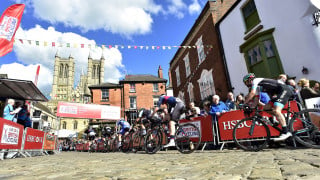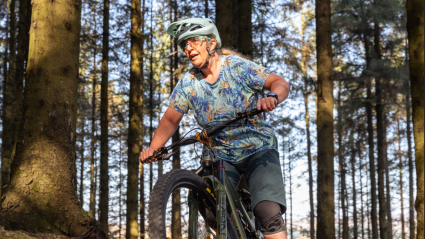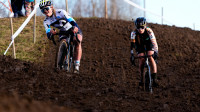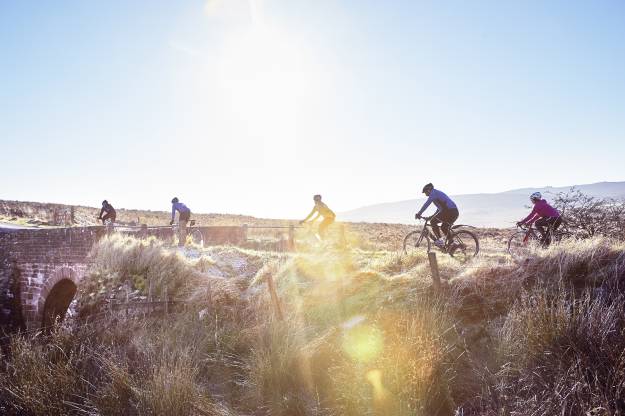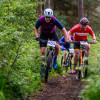Knowledge Level: Intermediate
For the pros, early spring means the cobbled roads of northern France and Belgium and, with sportives on offer to test yourself on the same iconic pavé and UK sportive organisers seeking out our rough roads to give you a taste of the Spring Classics, knowing how to ride cobbles is a key skill.
Speed is your friend
Don’t be tentative but try to increase your speed and attack the cobbles as the extra momentum will carry you over the lumps and bumps more smoothly. Try to add some sustained hard 3-5 minute efforts into your long rides or include regular Ramped VO2 intervals into your training.
Gear up
Try to ride flat, downhill or gently climbing cobbled sectors using your big chain-ring. This will maintain chain tension, reduce chain slap and prevent your chain jumping off. A compact chainset and a wide ranging cassette will help you to manage this even when you are tiring.
Look ahead
Pick your line, anticipate the actions of riders ahead and look where you want to go. If there is a big gap in the cobbles or an uneven edge you want to avoid, don’t look at it but where you want to go to avoid it.
Be first
When you hit the cobbles, the best place to be is on the front as you will get a clear ride and won’t have to contend with riders falling in front of you. Do some route research, check where the cobbled sectors are and tape this information to your stem. You will then know when to try and move up through the field.
Be last
Unfortunately, with big sportive fields and everyone else wanting the front spot, being on the front can be hard. Another option is to slow up, let the group you’re with go ahead and give yourself a bit of space. Also, if you watch the pros, you will notice that they leave larger than normal gaps on cobbles and you should adopt this tactic too. Assume that the rider in front of you is going to crash and give yourself enough space so that you have at least a chance of avoiding them.
Keep relaxed
Don’t tense up and don’t try to fight the bike. Grip the bars firmly but also keep your arms and upper body as relaxed and loose as possible. Let the bike flow underneath you, correct itself and don’t over react to small slips.
Tops or drops
Your hands are more secure either on the bar tops or down on the drops. It is recommended that you do not ride on the hoods as it is very easy for your hands to bounce off.
Stay on the crown
Although often the bumpiest, on cobbled roads, the crown is usually the best place to ride. The cobbles will be less broken up, will tend to have less mud on and there will be fewer gaps as fewer vehicles will have passed over them. Avoid the cambered lines on either side of the crown, especially if the cobbles are wet or muddy.
Avoid the verges
The verges may look smoother and tempting but there are often deep wheel swallowing holes hidden by puddles and puncture causing flints and debris that has washed off the cobbles.
Steer with your hips
If you need to alter your line to pass a rider, keep your speed up and initiate the change in direction positively with your hips. Don’t try to turn by using your handlebars as you are far more likely to experience a front wheel slide or catch it in a gap.
Recover in the wheels
Between the cobbled sectors, try to regroup and sit in the wheels to recover. It can be tempting to try and push on when you hit the smooth tarmac but you are better saving your energy for the next sector of pavé.
Practice
If you know that your event has rough sections or cobbles, practice riding them in training. Canal towpaths, converted railway line bike paths and forest fire roads can all be suitable for honing your “off-road” road bike skills. Also consider including some mountain biking and/or cyclo-cross in your training to develop your bike handling skills.

Cobbled climbs
The cobbled climbs typical of the Tour of Flanders and the Ronde Van Calderdale, are relatively short but steep. Often, damp conditions mean you can’t stand out of the saddle and easily maintain traction so work on your low cadence/high gear seated climbing. Make sure you select appropriate gearing. Choose the wheel you follow carefully and give yourself a bit of room as, if the rider ahead of you stalls suddenly, you will struggle to get going again if you are forced to stop and unclip.
Kit for cobbles
The pros’ mechanics will make a number of tweaks to their bikes which you can easily adopt for your own cobbled rides.
- Use higher volume 28 mm+ tyres if your frame has adequate clearance, as these will give a plusher ride and be less likely to puncture at the lower pressure you will need to run.
- Pros will ride tubulars but for amateurs, without mechanical support and endless spare wheels, road tubeless tyres offer a more practical choice with many of their handling and puncture resistant advantages.
- Some pros will still ride their deep section carbon wheels but many will return to traditionally spoked box section alloy rims for improved strength and a more forgiving ride.
- Many pro riders have additional cyclo-cross style bar-top levers fitted and this is option worth considering.
- A double wrap of bar-tape or gel pads under the tape can really help soak up the pounding from the cobbles.
- Alloy bottle cages can be bent slightly inwards to give a firmer grip.
- 500 ml bottles resist bouncing out better than 750 ml ones and a wrap of tape around them gives a more secure fit.
- Ditch saddle packs, frame mounted pumps and make sure your computer mount is secure.

